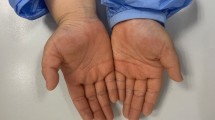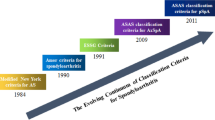Summary
The Pathogenesis of Darier-Grönblad-Strandberg syndrome is discussed in relation to biochemical data of 31 patients with classical features. Specific deviations from normal values were found as to the metabolism as well of collagen as glycosaminoglycans. The corresponding parameters: 1. Collagen-like protein in plasma, free hydroxyproline in plasma, activity of collagen proline hydroxylase in serum and skin, total hydroxyproline in urine, 2. hexuronic acid and hexosamine excretion in the urine, glycosaminoglycan fractions in urine—except the collagen proline hydroxylase activity—were significantly different from the values of corresponding age-matched healthy control persons. Interaction of collagen and glycosaminoglycans is not clear, the primary defect is unknown. Hereditary trait suggests rather an enzyme deficiency than an abnormal gen product.
Zusammenfassung
Pathogenetische Fragen zum Darier-Grönblad-Strandberg-Syndrom werden anhand biochemischer Untersuchungsergebnisse an einem Krankengut von 31 klassischen Fällen diskutiert. Es ergaben sich krankheitsspezifische Abweichungen von der Norm sowohl im Stoffwechsel des Kollagens als auch der Glykosaminoglykane. Die entsprechenden Parameter: 1. Konzentration des „collagen-like protein“ im Plasma, des freien Hydroxyprolins im Plasma, Gesamthydroxyprolinausscheidung mit dem Urin, Aktivität der Kollagenprolinhydroxylase in Serum und Haut, 2. Hexuronsäure-und Hexosaminausscheidung mit dem Urin, Glykosaminoglykanfraktionen im Urin — waren mit Ausnahme der Kollagenprolinhydroxylaseaktivität signifikant von den Meßwerten bei altersentsprechenden Gesunden verschieden. Wieweit sich hierbei Kollagen- und Glykosaminoglykanstoffwechsel gegenseitig beeinflussen, muß vorerst offen bleiben, ebenso die Frage nach dem Primärdefekt. Nach dem Vererbungsmodus ist dieser wahrscheinlicher in einem Enzymmangel als in der Bildung eines abnormen Genprodukts zu vermuten.
Similar content being viewed by others
Literatur
Astrup, P.: On the determination of heparin in blood, plasma and urine. Acta pharmacol. (Kbh.)3, 165 (1947)
Carlborg, U.: Study of circulatory disturbances, pulse wave velocity and pressure pulses in larger arteries in cases of pseudoxanthoma elasticum and angioid streaks. Acta med. scand., Suppl.151, 1 (1944)
Carlborg, U., Ejrup, B., Grönblad, E., Lund, F.: Vascular studies in pseudoxanthoma elasticum and angioid streaks. Acta med. scand.350, 1 (1959)
Cartwright, E., Danks, D. M., Jack, J.: Metachromatic fibroblasts in pseudoxanthoma elasticum and Marfan's syndrome. Lancet1969I, 533
Cocco, A. E., Grayer, D. J., Walker, B. A., Martyn, L. J.: The stomach in pseudoxanthoma elasticum. J. Amer. med. Ass.210, 2381 (1969)
Connor, P. J., Juergens, J. L., Perry, O. H., Hollenhorst, R. W., Edwards, J. F.: Pseudoxanthoma elasticum and angioid streaks. Amer. J. Med.30, 537 (1961)
Darier, J.: Pseudoxanthoma elasticum. Mschr. Prakt. Derm.23, 609 (1896)
Goodman, R. M., Smith, E. W., Paton, D., Bergman, R. A., Siegel, C. L., Ottesen, O. E., Shelley, W. M., Pusch, A. L., McKusick, V. A.: Pseudoxanthoma elasticum, a clinical and histological study. Medicine (Baltimore)42, 297 (1963)
Grönblad, E.: Angioid streaks—pseudoxanthoma elasticum. Acta ophthal. (Kbh.)7, 329 (1929)
Hannay, P. W.: Some clinical and histopathological notes on pseudoxanthoma elasticum. Brit. J. Derm.63, 92 (1951)
Hutton, J. J., Tappel, A. L., Udenfriend, S.: A rapid assay for collagen proline hydroxylase. Analyt. Biochem.16, 384 (1966)
Junge-Hülsing, G.: Untersuchungen zur Pathophysiologie des Bindegewebes. Heidelberg: Hützig 1965
Kaplan, L., Hartman, S. W.: Elastica disease. Case of Grönblad-Strandberg syndrome with gastrointestinal hemorrhage. Arch. intern. Med.94, 489 (1954)
Knapp, H.: On the formation of dark angioid streaks as an unusual metamorphosis of retinal hemorrhage. Arch. Ophthal.21, 289 (1892)
Kreysel, H. W., Lerche, W., Jänner, M.: Beobachtungen zum Grönblad-Strandberg-Syndrom. Hautarzt18, 24 (1967)
Langness, U.: Hydroxyprolinausscheidung und Kollagenstoffwechsel. Dtsch. med. Wschr.95, 1530 (1970a)
Langness, U.: „Collagen-like protein“. Dtsch. med. Wschr.95, 475 (1970b)
Le Roy, E. C., Kaplan, A., Udenfriend, S., Sjoerdsma, A.: A hydroxyproline-containing, collagen-like protein in plasma and a procedure for its assay. J. biol. Chem.239, 3350 (1964)
Maurice, P.: Coronary insufficiency in elastorrhexis. Ann. Cardiol. Angiol. (Paris)17, 301 (1968)
McKusick, V. A.: Heritable disorders of connective tissue. St. Louis (USA): C. V. Mosby 1966
Merker, H. J., Struwe, K.: Elektronenmikroskopische Untersuchungen zum Problem der Sekretion der bindegewebigen Interzellularsubstanz. Z. Zellforsch.115, 212 (1971)
Prockop, D. J., Udenfriend, S.: A specific method for the analysis of hydroxyproline in tissues and urine. Analyt. Biochem.1, 228 (1960)
Reveel, S. T., Carey, T. N.: Pseudoxanthoma elasticum as a disseminated disease. Sth. med. J. (Bgham, Ala.)41, 782 (1948)
Sairanen, E.: Pseudoxanthoma elasticum and joint manifestation. Acta rheum. scand.16, 130 (1970)
Schiller, S., Slover, G. A., Dorfman, A.: A method for the separation of acid mucopolysaccharides. J. biol. Chem.236, 983 (1961)
Sheie, G. H., Freeman, N. E.: Vascular disease associated with angioid streaks of the retina and pseudoxanthoma elasticum. Arch. Ophthal.35, 3 (1946)
Smith, J. G., Sams, W. M., Davidson, E. A., Clark, R. D.: Pseudoxanthoma elasticum. Histochemical and biochemical alterations. Arch. Derm.86, 741 (1962)
Smith, J. G., Davidson, E. A., Taylor, R. W.: Cutaneous acid mucopolysaccharides in pseudoxanthoma elasticum. J. invest. Derm.43, 429 (1964)
Strandberg, J.: Pseudoxanthoma elasticum. Zbl. Hautu. Geschl.-Kr.31, 689 (1929)
Uitto, J., Lindy, S., Turto, H., Danielsen, L.: Biochemical characterization of pseudoxanthoma elasticum; collagen biosynthesis in the skin. J. invest. Derm.57, 44 (1971)
Urbach, E., Wolfram, S.: Über Veränderungen des elastischen Gewebes bei einem autoptisch untersuchten Falle von Grönblad-Strandbergschem Syndrom. Arch. Derm. Syph. (Berl.)176, 167 (1938)
Embden Andres, G. H. van: Afwijkugen aan de inwendige organen bij Pseudoxanthoma Elasticum en Angioide Stregpen. Groningen 1952
Whitcomb, F. F., Brown, C. H.: Pseudoxanthoma elasticum. Report of twelve cases: massive gastrointestinal hemorrhage in one patient. Ann. intern. Med.56, 834 (1962)
Author information
Authors and Affiliations
Rights and permissions
About this article
Cite this article
Langness, U., Kreysel, H.W., Thiel, H.J. et al. Pathogenetische Fragen zum Darier-Grönblad-Strandberg Syndrom. Klin Wochenschr 52, 185–189 (1974). https://doi.org/10.1007/BF01614395
Issue Date:
DOI: https://doi.org/10.1007/BF01614395
Key words
- Pathogenesis of Darier-Grönland-Strandberg syndrome
- collagen-like protein
- free hydroxyproline
- total hydroxyproline in urine
- collagen proline hydroxylase activity
- glycosaminoglycans




